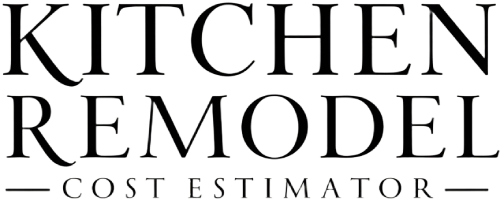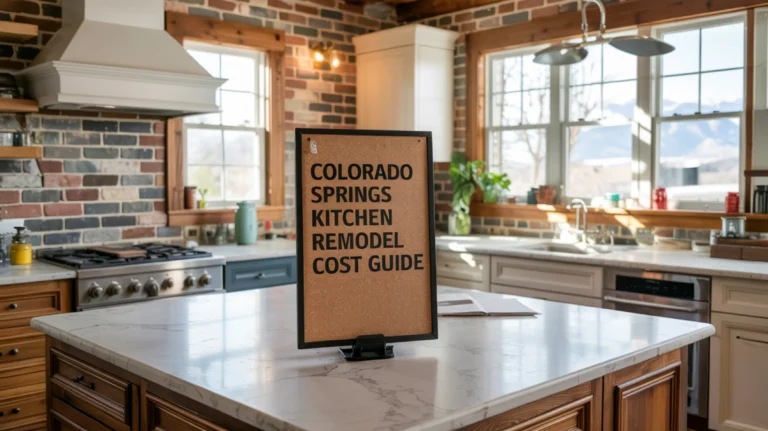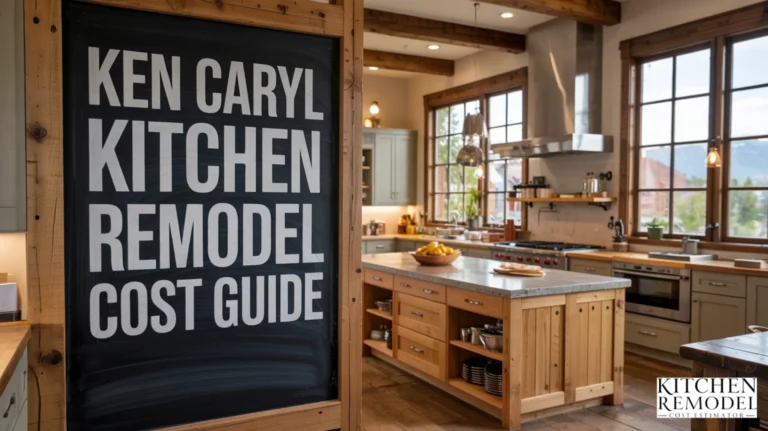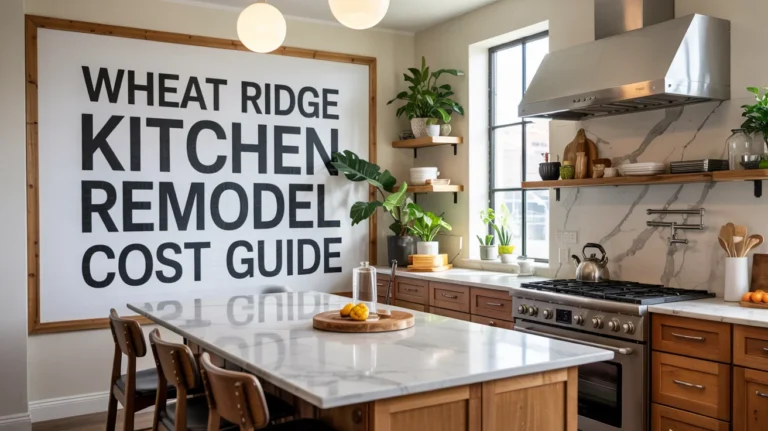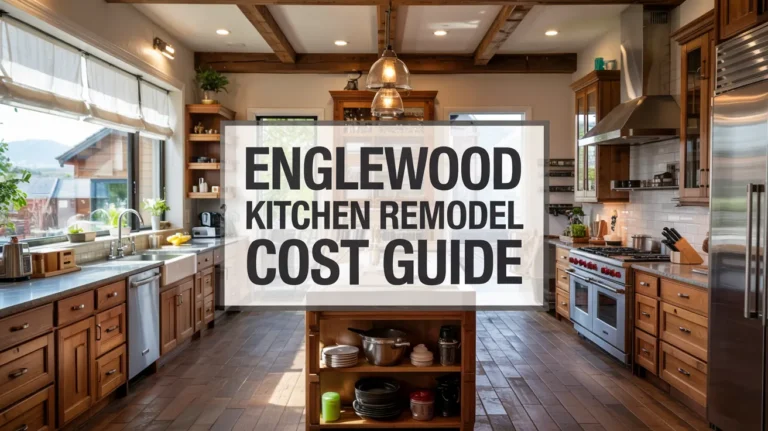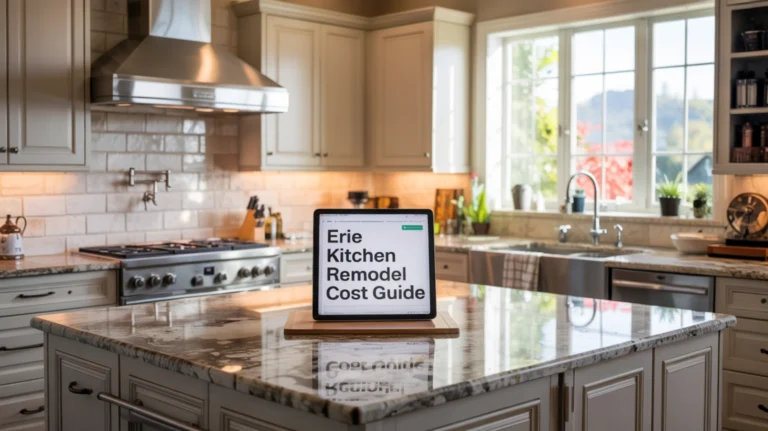Kitchen renovations in Aurora follow the same rule as Colorado’s weather—what you experience depends entirely on where you’re standing. A cosmetic refresh and a structural transformation might share the same zip code, but they exist in completely different budget universes.
So what’s your kitchen remodel in Aurora actually going to cost?
The average kitchen remodel cost in Aurora, Colorado ranges from $16,000 to $46,000. Basic remodels may start at $12,000, while high-end renovations with custom finishes, upgraded appliances, and structural changes can exceed $65,000 depending on scope and material choices.
Kitchen Remodel Cost Estimator for Aurora, Colorado
Aurora Kitchen Remodel Cost Calculator
Get an estimate for your kitchen renovation based on your specifications.
Estimated Kitchen Remodel Cost
This estimate is based on national averages and may vary based on your location, material availability, contractor rates, and other factors. Prices are estimates only and should be used for planning purposes.
Looking for more accurate costs in your area? Search for location-specific remodel costs.
Kitchen Remodel Cost Benchmarks: Aurora, Colorado

Project Scale Cost Ranges
Planning a kitchen remodel in Aurora? The number one question is almost always about cost. And the frustrating answer? It depends.
flowchart TB
A[Kitchen Remodel Scales] --> B[Minor Cosmetic Updates]
A --> C[Mid-Range Remodel]
A --> D[Major Upscale Renovation]
B --> B1["🏠 Cost Range: $7,000 - $15,000
• Cabinet Refacing
• Entry-Level Appliances
• Laminate Counters
• Vinyl Flooring"]
C --> C1["🏡 Cost Range: $20,000 - $50,000
• Semi-Custom Cabinets
• Granite/Quartz Counters
• Energy-Efficient Appliances
• Hardwood/Tile Flooring"]
D --> D1["🏘️ Cost Range: $50,000 - $150,000+
• Custom Cabinets
• Premium Stone Counters
• Pro-Grade Appliances
• Potential Layout Changes"]
style A fill:#4a90e2,color:white,stroke-width:2px
style B fill:#7ed321,color:black
style C fill:#f5a623,color:black
style D fill:#d0021b,color:white
style B1 fill:#e6f2d9,color:black
style C1 fill:#fff2cc,color:black
style D1 fill:#f9d6d6,color:blackBut don’t worry—I can help translate that vague “it depends” into something a bit more concrete.
The price of your dream kitchen remodel hinges primarily on scope. Are you looking for a quick refresh or a magazine-worthy transformation? The difference isn’t just aesthetic—it’s thousands of dollars.
Minor Cosmetic Updates
Think of minor updates as kitchen makeovers rather than full renovations. You’re keeping the existing layout but giving everything a facelift.
What fits into this category? Cabinet refacing or painting, swapping in new entry-level appliances, installing budget-friendly countertops like laminate, updating the sink and faucet, laying down vinyl flooring, and applying fresh paint.
In Aurora (using Denver-area figures as our proxy), these types of updates typically run between $7,000 and $15,000.
Some sources suggest a minimum threshold of $8,000 for any kitchen remodel, while others claim “minor” remodels can reach up to $24,000.
Why such a wide range? Because “minor” is more about what you keep than what you change.
A project focused solely on painting cabinets and adding new hardware might cost just a fraction of what you’d spend to install new laminate countertops and vinyl flooring—even though both qualify as “minor” updates because they maintain the original layout.
This is why defining exactly what you want to change is crucial for accurate budgeting. Otherwise, “minor” might end up having major implications for your wallet.
Mid-Range Remodels
Ready to take your kitchen renovation up a notch? Mid-range remodels are where things get interesting.
These projects involve replacing most of your kitchen’s components but typically maintain the original layout. Why keep the layout? Because relocating plumbing and electrical services is where costs can skyrocket.
What might your mid-range project include? Semi-custom cabinetry (perhaps with that island you’ve been dreaming about), granite or quartz countertops, energy-efficient appliances, updated lighting fixtures, hardwood or tile flooring, and fresh paint throughout.
So what’s the damage to your bank account? For mid-range remodels in Aurora, most homeowners spend between $20,000 and $50,000.
This range lines up with figures reported throughout Colorado, Denver, and neighboring Centennial. While some local sources suggest you might get away with as little as $11,000-$25,000, this discrepancy likely comes from how different contractors define “mid-range” or variations in their market sampling.
National averages support the $20,000-$50,000 range, with most projects landing around $25,000 to $35,000. Many contractors suggest a budget of $30,000 as a solid starting point for meaningful changes in this tier.
Kitchen Remodel Cost Ranges by Scale (Aurora, CO Estimates)
| Project Scale | Typical Scope | Estimated Cost Range (Aurora Proxy) | Key Sources |
|---|---|---|---|
| Minor Cosmetic Updates | Cabinet refacing/painting, entry-level appliances, laminate counters, new sink/faucet, vinyl flooring, paint. Existing layout retained. | $7,000 – $15,000 | 1 |
| Mid-Range Remodel | Semi-custom cabinets, possible island, granite/quartz counters, new energy-efficient appliances, updated lighting, hardwood/tile flooring, paint. Existing layout retained. | $20,000 – $50,000 | 2 |
| Major Upscale Renovation | Custom cabinets, premium stone counters, pro-grade/smart appliances, custom lighting, upscale flooring, designer fixtures. Often includes layout/structural changes. | $50,000 – $150,000+ | 1 |
Major Upscale Renovations
Now we’re talking about kitchens that make your neighbors jealous. Major upscale renovations represent the pinnacle of kitchen transformations.
These projects often involve layout modifications, structural changes, and premium materials from floor to ceiling. We’re talking custom cabinetry, high-end countertops (granite, quartz, marble, or the increasingly popular quartzite), professional-grade or smart appliances, and specialized lighting systems including undercabinet illumination.
Add in upscale flooring like premium hardwood or designer tile, high-end fixtures, and possibly relocating walls or utility lines, and you’ve got a recipe for both stunning results and significant expense.
So what’s the investment for kitchen envy? For upscale renovations in Aurora, expect the starting point to be around $50,000, with costs potentially reaching $150,000 or significantly more.
This range aligns with local contractor estimates and national benchmarks. Some sources cite specific ranges of $38,000-$150,000+ and $50,000-$150,000, while national figures suggest $50,000-$100,000+ is typical.
Need proof? Real projects back up these numbers. Homeowners report spending $55,000 (not including flooring), $80,000, and even $183,000 for truly extensive renovations.
What pushes costs into the stratosphere? Moving beyond simple replacements to complete redesigns.
Layout changes and structural work fundamentally increase project complexity. When you start moving walls, plumbing, or electrical, you’re not just paying for materials—you’re paying for engineering expertise, specialized labor, and additional permits.
This level of customization creates a truly bespoke kitchen, but comes with a price tag to match.
Cost Per Square Foot Analysis
Ever wonder how to make sense of wildly different kitchen remodel quotes? Cost per square foot gives us a common language to compare projects—though even this metric is heavily influenced by scope, materials, and complexity.
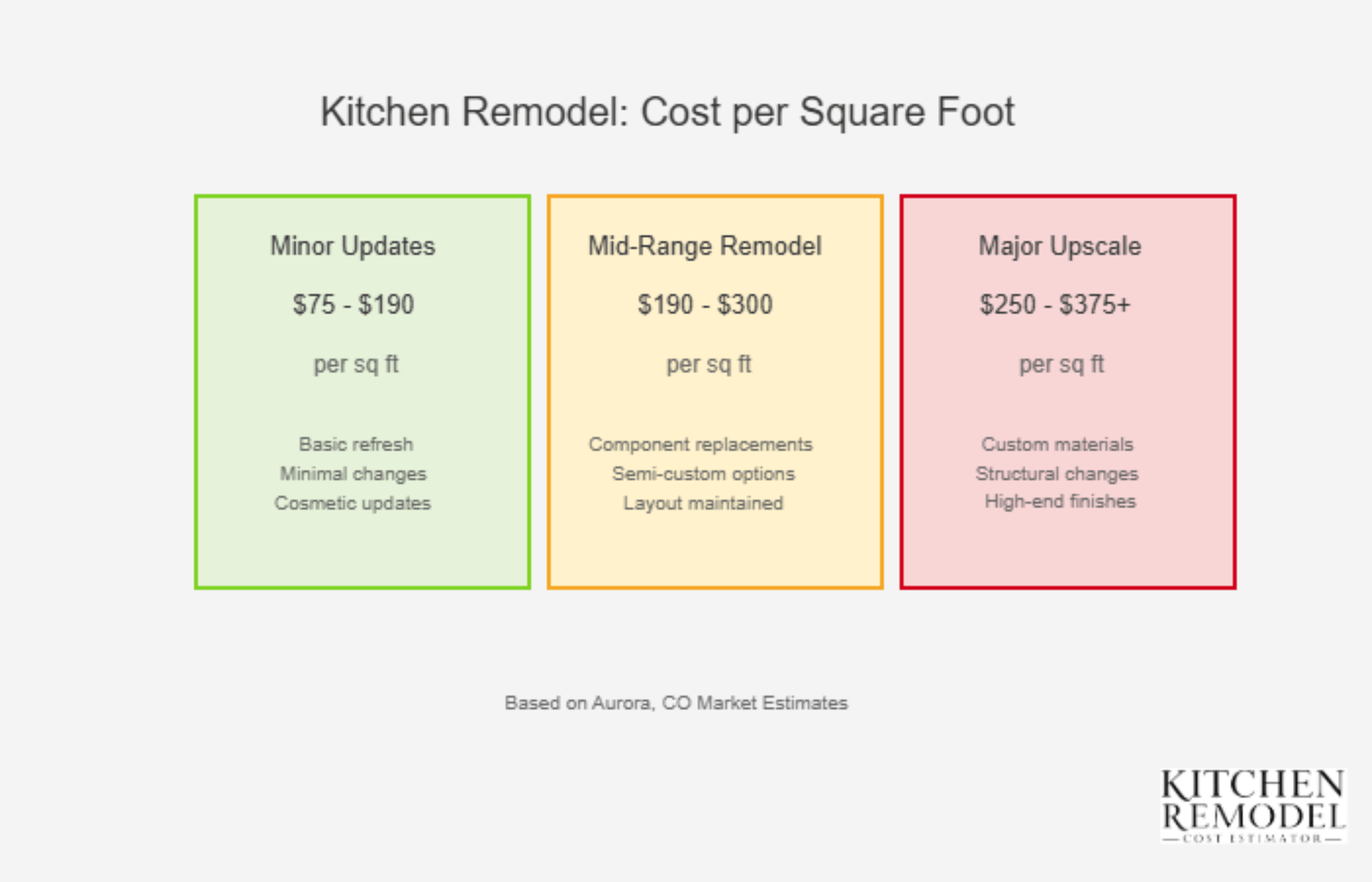
Typical Ranges in Aurora Area
In the Aurora vicinity, expect to pay between $100 and $375 per square foot for your kitchen remodel.
Where does this range come from? Denver-focused data suggests a general span of $100-$250 per square foot (with simple cosmetic updates potentially dipping as low as $75 per square foot). Other sources indicate a broader estimate of $190-$375 per square foot.
What determines where you fall in this spectrum? Your project’s ambition.
Simple cosmetic updates cluster at the lower end ($75-$100/sq ft). Mid-range renovations start climbing the scale, while upscale renovations with premium materials and complex work can push toward or even beyond that $375 per square foot ceiling.
Of course, the absolute cost scales with your kitchen’s size. It’s simple math—more square footage means more materials and labor.
Denver-based estimates illustrate this relationship in stark terms:
- Small kitchen (70-100 sq ft): typically costs between $13,300 and $37,500
- Medium kitchen (100-200 sq ft): ranges from $19,000 to $75,000
- Large kitchen (200+ sq ft): can cost from $55,000 to $112,500 or more
That means a high-end remodel of a large kitchen could easily approach or exceed $100,000—while a basic refresh of a small kitchen might be completed for under $15,000.
Estimated Cost per Square Foot for Kitchen Remodels (Aurora, CO Area)
| Project Scale | Estimated Cost per Square Foot | Key Sources | Notes |
|---|---|---|---|
| Minor Cosmetic Updates | $75 – $190 | 2 | Lower end reflects basic refresh; higher end overlaps with mid-range. |
| Mid-Range Remodel | $190 – $300 | 2 | Varies significantly based on material quality and specific upgrades. |
| Major Upscale Renovation | $250 – $375+ | 2 | Upper range reflects custom work, premium materials, layout changes. |
Financial Performance Metrics
Return on Investment (ROI) Projections
Will your kitchen renovation pay for itself when you sell? That’s the million-dollar question—or in this case, perhaps the $50,000 question.
Return on Investment quantifies what you’ll get back from your remodeling investment at sale time. It’s the financial reality check for your renovation dreams.
The gold standard for this data is the Remodeling Magazine Cost vs. Value report, which tracks projects across the country.
Minor Midrange Kitchen Remodels consistently take the ROI crown among kitchen projects. The 2024 national data shows an impressive 96.1% cost recoupment rate. That means for an average investment of $27,492, homeowners saw a resale value increase of $26,406.
That’s substantially better than the 2023 figure of 85.7%, suggesting these projects are increasingly valued in the current market.
Why do minor remodels perform so well? They focus on cost-effective changes that maximize visual impact without breaking the bank. Buyers can see the improvement, but you haven’t priced yourself out of return territory.
Major Midrange Kitchen Remodels yield more modest returns. The 2024 national average shows a 49.5% cost recoupment—you’ll get back roughly half of what you spend. For the average project costing $79,982, that translates to $39,587 in added resale value.
Interestingly, the Mountain region (which includes Colorado) performs better than the national average. One source cites a 67.2% ROI for major midrange kitchen remodels in our region.
Major Upscale Kitchen Remodels produce the lowest ROI, with 2024 national data showing just 38.0% recoupment. That means a project averaging $158,530 only adds about $60,176 to your home’s value.
This stark disparity tells us something important about renovation motivations.
Minor updates (80-90%+ ROI) are financially efficient investments that the market clearly values. But those expansive, high-end renovations (below 50% ROI) suggest a different motivation—personal enjoyment rather than financial return.
When you spend $150,000 on a kitchen knowing you’ll only recoup $60,000 at sale, you’re effectively “paying” $90,000 for the pleasure of using that perfect kitchen until you move.
Is that worth it? Only you can decide. But understanding these numbers helps make that decision with eyes wide open.
Return on Investment (ROI) for Kitchen Remodels (Regional/National Data)
| Project Scale | 2024 National ROI | 2024 Mountain Region ROI | Key Sources | Notes |
|---|---|---|---|---|
| Minor Midrange Kitchen Remodel | 96.1% | N/A | 10 | Highest ROI category, cost-effective upgrades. |
| Major Midrange Kitchen Remodel | 49.5% | 67.2% | 10 | Moderate ROI, potential for significant regional variation. |
| Major Upscale Kitchen Remodel | 38.0% | N/A | 10 | Lowest ROI, costs driven by customization and high-end materials. |
Regulatory Requirements: City of Aurora
Think you can skip permits for your Aurora kitchen remodel? Think again. Navigating building codes and permitting procedures isn’t just bureaucratic red tape—it’s a mandatory aspect of most kitchen projects that ensures both legal compliance and your family’s safety.
Building Codes and Standards
Aurora’s building regulations aren’t created in a vacuum. The city adopts codes based on the International Code Council’s (ICC) standards, but with local amendments specific to Aurora’s needs. These regulations are codified in the Aurora Municipal Code, which you can access online.
Where should you look for kitchen remodel requirements? Start with Chapter 22 (Buildings & Building Regulations), which contains provisions from general building codes, residential codes, mechanical codes, plumbing codes, fuel gas codes, and existing building codes—plus Aurora-specific amendments.
Depending on your project’s scope, you might also need to check Chapter 66 (Fire Prevention and Fire Protection) and the city’s Unified Development Ordinance (UDO), particularly Chapter 146, which addresses zoning regulations and standards for building materials and design elements.
Within Chapter 22, several sections might apply to your kitchen project:
- Standards for structural design criteria
- Subflooring and drywall installation requirements
- Electrical systems regulations (Article VII)
- Mechanical systems and ventilation standards (Article VIII)
- Plumbing installation requirements (Article X)
- Gas appliance regulations (Article IX)
If your remodel affects exterior walls, don’t forget UDO Section 146-4.8.6, which specifies permitted exterior building materials and masonry requirements for homes.
Permitting Process
Let’s be crystal clear: You need a building permit for kitchen renovations in Aurora.
The only exceptions are truly minor work like repairing drywall or installing basic shelving. Everything else—new cabinets, countertops, relocated plumbing, electrical changes—requires proper permits.
Why not skip this step? Because unpermitted work creates headaches that far outweigh any short-term savings. When you eventually sell your home, unpermitted renovations can derail your closing, potentially requiring costly rework to bring everything up to code.
Ready to do things right? Aurora makes it relatively straightforward:
Permit applications can be submitted electronically through Aurora4Biz.org, the City’s online portal. If you prefer paper, in-person submissions at the Aurora Municipal Center’s Permit Center are available, though appointments are recommended.
You’ll need detailed plans and drawings, typically in PDF format. City staff will review your plans before issuing permits, checking for code compliance and structural considerations.
Permit fees vary based on your project’s scope and valuation. For specific costs, consult Aurora’s official fee schedule or tools like their Permit Fee Calculator on AuroraGov.org/Building.
Once work begins, inspections are mandatory at various construction phases. You or your contractor must schedule these inspections, which can typically be done online or by contacting the Building Division directly.
Municipal Contact Information
- Building Division: 303.739.7420
- Email: [email protected]
- Website: AuroraGov.org/Building
- Online Portal: Aurora4Biz.org
- Address: Aurora Municipal Center, 15151 E. Alameda Parkway, Aurora, CO 80012
- Hours: Monday, Tuesday, Thursday, Friday: 7:30 AM – 4:30 PM; Wednesday: 8:30 AM – 4:30 PM (In-person services typically 9 AM – 4 PM; appointments suggested)
Material and Construction Standards
Ever wondered how to tell if those cabinets will actually last? Or if your countertops can handle the abuse your family dishes out? Industry standards provide objective measures of quality that go far beyond marketing claims.
Industry Standards Compliance
Cabinetry
Not all cabinets are created equal. The ANSI/KCMA A161.1 standard, developed by the Kitchen Cabinet Manufacturers Association, puts cabinets through rigorous testing that simulates years of household use.
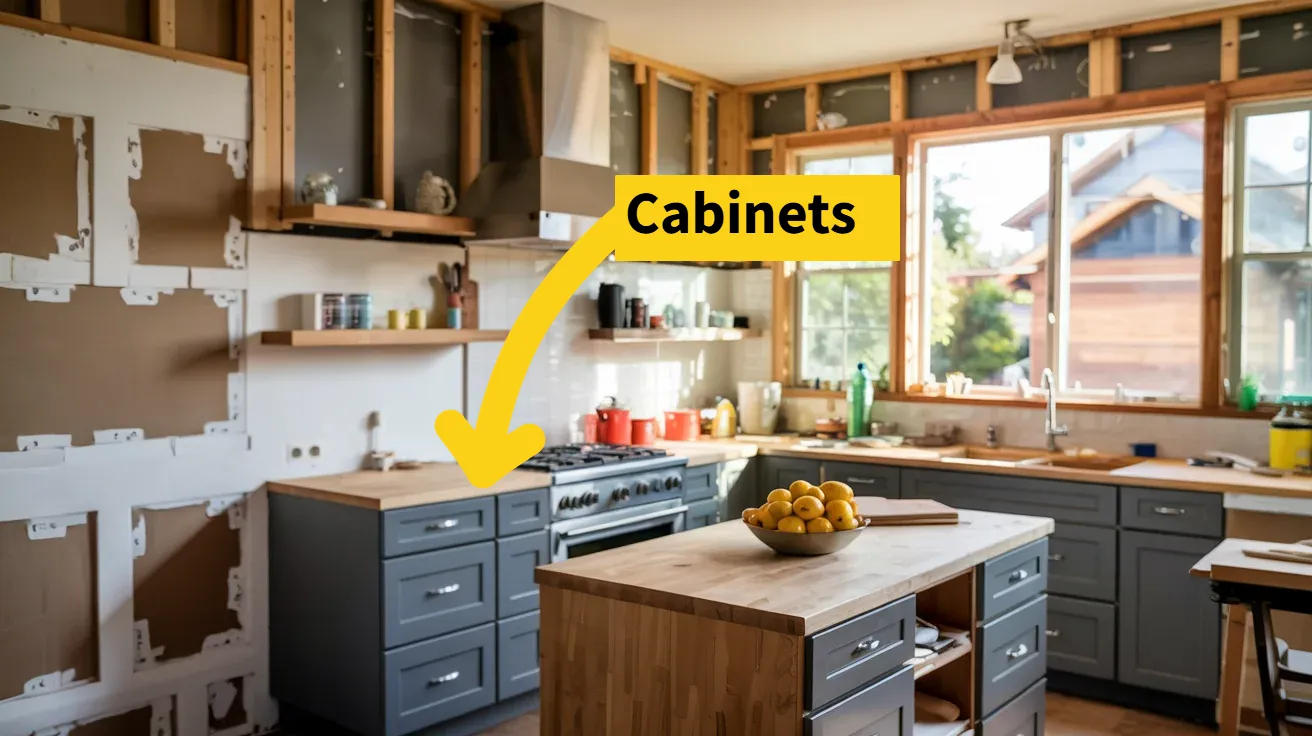
What’s being tested? Everything that matters. Certified cabinets must pass evaluations for structural strength (can shelves hold your dishes without sagging?), drawer and door durability (will they survive thousands of openings?), and finish resilience against heat, cold, and common kitchen spills like vinegar, juice, coffee, and oil.
When you see this certification, you know the cabinet meets specific construction requirements for rigidity, joinery, and hardware quality. For truly high-end applications, look for the ANSI/AWI 1232 standard from the Architectural Woodwork Institute, which addresses both performance and aesthetics.
Countertops
The ANSI/AWI 1236 standard tells you if your countertop can handle real life. It specifies minimum load resistance (50 lbs per 144 sq. in.), limits on how much it can bend under weight, and overhang constraints (max 12″ from support without special engineering).
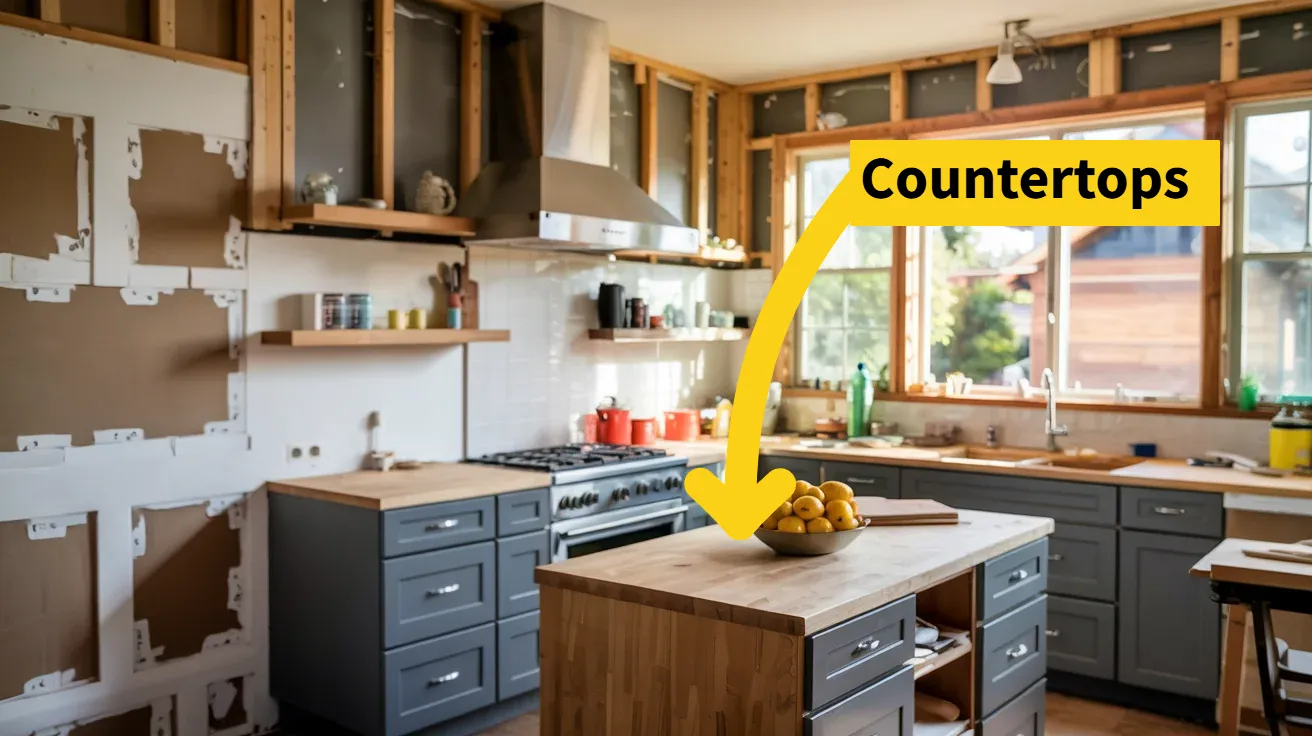
Substrate materials—particularly under sinks—are critical failure points in many kitchens. Standards reference ASTM D1037 test methods for evaluating wood-based panels, often specifying particleboard or fiberboard with low 24-hour thickness swell factors (5.5% or less) for moisture resistance.
For solid results, particleboard should meet ANSI A208.1 (Grade M-2 exterior glue recommended), while MDF should comply with ANSI A208.2.
Flooring
Popular luxury vinyl tile (LVT) and planks should meet ASTM F3261 requirements for wear surface durability, dimensional stability under heat, resistance to indentation, and resistance to damage from light, heat, and chemicals.
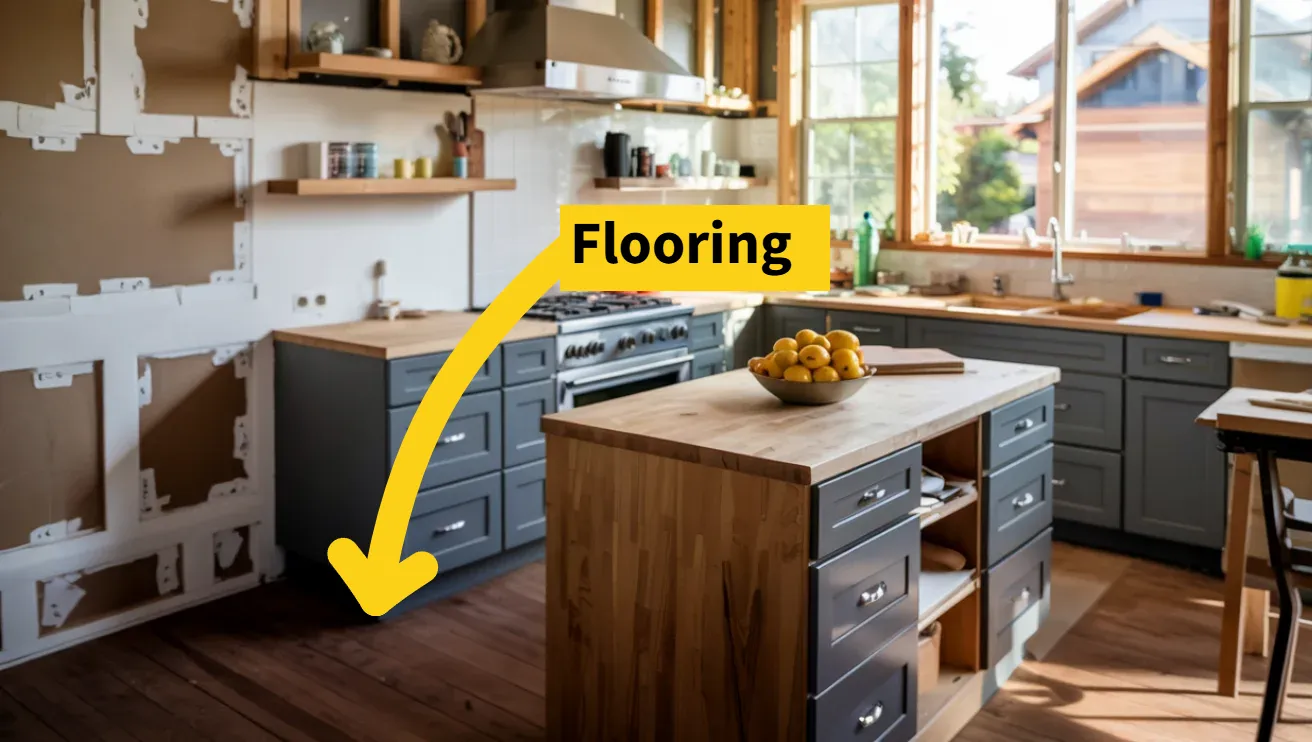
For tile flooring, safety in potentially wet kitchen areas is addressed by ANSI A137.1, which measures the Dynamic Coefficient of Friction (DCOF). A value of 0.42 or greater is recommended for surfaces expected to be walked on when wet—translation: less chance of slipping on that spilled pasta water.
Material Safety
While primarily focused on commercial settings, NSF/ANSI 51: Food Equipment Materials establishes important safety principles relevant to residential kitchens. It limits potentially harmful substances (like lead) and specifies criteria for cleanability, corrosion resistance, and durability for materials intended for food contact zones.
Products meeting these criteria provide assurance about the safety of surfaces like countertops or cutting boards.
Referencing these established ANSI, KCMA, ASTM, and NSF standards gives you objective benchmarks for evaluating material quality. Instead of relying on subjective claims, you can make informed decisions based on standardized testing and performance criteria.
Key Material and Construction Standards Summary
| Standard | Scope / Focus | Relevant Materials / Components | Key Sources |
|---|---|---|---|
| ANSI/KCMA A161.1 | Performance & Construction (Structure, Durability, Finish) | Kitchen Cabinets | 27 |
| ANSI/AWI 1232 | Aesthetic & Performance (Architectural Grade) | Manufactured Wood Casework | 30 |
| ANSI/AWI 1236 | Structural Requirements, Joinery, Material Specifics | Countertops | 31 |
| ASTM D1037 | Test Methods for Wood-Based Panels (e.g., Moisture Resistance) | Countertop Substrates | 31 |
| ASTM F3261 | Performance Specs (Wear, Stability, Resistance) | Rigid Core Resilient Flooring | 33 |
| ANSI A137.1 (DCOF) | Dynamic Coefficient of Friction (Slip Resistance) | Tile Flooring | 35 |
| NSF/ANSI 51 | Material Safety (Formulation, Cleanability, Corrosion Resistance) | Food Contact Surfaces | 36 |
Cost Components in Aurora Market
Wondering where all your kitchen renovation dollars actually go? Let’s break down the typical budget in the Aurora market, where materials and labor claim the lion’s share.
Material Pricing Estimates
Materials typically consume 65-70% of your total budget. This means your selection choices offer the biggest opportunity to control costs—or to watch them spiral upward.
Cabinetry (Stock, Semi-Custom, Custom): Here’s the single largest expense in most kitchen remodels. Why such a big chunk of your budget? Because cabinets aren’t just wood boxes—they’re the most visible component that defines your kitchen’s style and functionality.
Stock cabinets represent your most economical option but come with limited sizes and styles. Semi-custom cabinets provide more modifications and finishes at a mid-range price. Custom cabinets offer complete personalization but at premium prices.
What does this mean in dollars? Mid-range stock cabinetry for a full kitchen might run between $10,000 and $20,000, while high-end semi-custom or fully custom cabinetry can easily exceed $20,000. Real projects have reported spending $23,400 and even $45,000 on cabinetry alone.
Even individual cabinet units vary widely: basic base cabinets might cost $100-$500 each, while utility cabinets can range from $500-$3,000. With cabinetry eating approximately 29% of your budget, deciding between stock, semi-custom, and custom options gives you the most leverage for controlling total costs.
Countertops (Laminate, Solid Surface, Stone): Another major budget component, countertop prices hinge almost entirely on material selection.
Laminate offers the most wallet-friendly solution. Solid surface materials like Corian provide a mid-range alternative. Natural stones like granite and marble, along with engineered quartz, represent premium choices. Exotic stones like quartzite can cost substantially more—potentially double the price of standard quartz.
The financial impact of your choice is significant. Opting for laminate might save $2,000-$5,000 compared to stone or solid surface options. Example projects report quartz countertop costs around $6,000-$10,000, though another cited just $2,935, likely reflecting differences in scope or material grade.
Unlike cabinets, countertop costs often combine material price and fabrication/installation as closely linked expenses.
Appliances: Your appliance budget depends heavily on your ambitions. Basic functional models? Or pro-grade equipment with smart features?
Costs range from a few thousand dollars for standard appliances up to $10,000-$15,000 or more for premium selections. One detailed project breakdown showed an actual appliance expenditure of $12,494.
Energy Star certified models may cost more upfront but offer operational savings over time.
Flooring: Flooring costs depend on both material choice and square footage.
Vinyl provides the most affordable option (starting around $1/sq ft for material). Ceramic tile occupies the mid-range ($5-$10/sq ft material cost). Hardwood and natural stone represent premium choices ($10-$40/sq ft material cost).
Don’t forget installation, which adds significantly to total flooring expense. These costs vary widely—especially for tile, which can range from $5 to over $20 per square foot for installation alone.
Interestingly, a seemingly more expensive material might have a similar installed cost to a cheaper material with higher installation labor (e.g., $7/sq ft laminate vs. $5/sq ft ceramic tile plus $15/sq ft installation).
Fixtures: This category includes sinks, faucets, garbage disposals, lighting elements, and cabinet hardware. Costs span from basic functional items to designer pieces.
Sinks and faucets, particularly undermount sinks with designer faucets or water filtration systems, can represent a notable expense—one project reported $4,714 for sink-related items. Even cabinet hardware adds up, costing $1,158 in another example.
Labor Rate Considerations
Labor typically represents 30-35% of your overall budget. This percentage increases with project complexity, particularly if significant layout changes or structural work is involved.
General Contractor and Trade Rates: In the Denver metro area, including Aurora, hourly rates for contractors and skilled tradespeople commonly range from $50 to $150 per hour.
Specific rates depend on the trade involved (electricians, plumbers, tile installers, carpenters) and work complexity. Licensed specialists like plumbers and electricians typically command higher rates than general laborers.
Installation Costs: Beyond hourly rates, installation costs for major components contribute significantly. Cabinet installation, for instance, averages around $6,000 for a typical project.
As noted earlier, tile installation labor can range widely from $5 to over $20 per square foot depending on tile size, pattern complexity, and substrate preparation.
Don’t forget demolition and removal of existing materials—this adds to labor costs due to the time, effort, and disposal fees involved.
Estimated Cost Allocation for Mid-Range Kitchen Remodel (Aurora Market)
| Cost Category | Estimated Budget Allocation (%) | Key Sources | Notes |
|---|---|---|---|
| Cabinetry | ~29% | 3 | Largest single component, significant cost variation based on type (stock/semi/custom). |
| Labor & Installation | ~30-35% | 38 | Includes GC fees, trade labor (plumbing, electrical, install), demolition. Increases with complexity. |
| Appliances | ~14% | 3 | Varies greatly with brand, features (standard vs. high-end/smart). |
| Countertops | ~11% | 3 | Material choice (laminate vs. stone) is a major cost driver. |
| Flooring | ~7% | 3 | Depends on material (vinyl vs. tile/hardwood) and installation complexity. |
| Fixtures & Plumbing | ~5-10% | 1 | Includes sink, faucet, lighting, hardware. Can escalate with designer selections. |
| Other (Design, Permits) | ~Balance | 3 | Design fees, permit costs, contingency funds. |
Key Cost Influencers
Beyond basic material selection and standard labor rates, several critical factors can dramatically impact your kitchen remodel budget in Aurora. These “budget multipliers” often catch homeowners by surprise.
Impact of Design and Structural Modifications
Layout Changes and Complexity: Want to move your sink to the island or relocate your range? Prepare for significant cost increases.
Modifying your existing kitchen footprint—moving walls, relocating plumbing fixtures, changing appliance locations, or reconfiguring the overall flow—inevitably drives up expenses. Why? Because these changes require more extensive demolition, new framing, and complex re-routing of essential services.
When you move a sink, you’re not just installing a new fixture—you’re relocating water supply lines, drain pipes, and possibly venting. Moving a range might require extending gas lines or upgrading electrical circuits. Each change cascades into multiple specialized trades: demolition crews, framers, plumbers, electricians, drywallers, and painters.
This explains why simpler kitchen designs like galley layouts are generally less expensive to remodel compared to complex configurations like U-shaped kitchens with islands. The more complex your layout, the more coordination required—and coordination costs money.
Structural Alterations: Dreaming of an open concept? Removing or altering load-bearing walls represents a major structural intervention with considerable costs.
Such changes require professional engineering analysis to design appropriate support systems—typically involving installation of structural beams (like LVL or steel) and associated framing modifications. These structural changes trigger stringent code reviews and specific inspections during construction.
The financial impact? Substantial. Project examples cite costs of $7,204 for engineering and framing alone, or contributing significantly to a $25,000 line item for combined structural work, drywall, electrical, and plumbing.
The decision to move beyond replacing components to undertaking layout changes marks a critical threshold where project costs escalate dramatically. You’re no longer just updating finishes—you’re essentially rebuilding portions of your home.
Material Selection Effects
Stock vs. Custom Materials: The customization level you choose—particularly for cabinetry—profoundly impacts costs.
Stock cabinets come in standard sizes and limited finishes off-the-shelf, offering the lowest price point. Semi-custom cabinets allow some modifications in size, style, and finish at moderate price increases. Fully custom cabinets provide complete design freedom but at premium prices.
The difference between basic stock cabinetry and high-end custom options for a full kitchen can easily reach $10,000-$20,000 or more. This single decision might determine whether your remodel falls into the mid-range or upscale category.
Quality Tiers: Within nearly every material category—countertops, flooring, appliances, fixtures—multiple quality tiers exist, each with different price points.
Selecting high-end materials like imported marble countertops, professional-grade cooking ranges, exotic hardwood flooring, or custom-designed tile backsplashes significantly elevates your budget compared to builder-grade or mid-range alternatives.
Beyond initial cost, consider how durability, maintenance requirements, and long-term performance vary across quality tiers. Sometimes spending more upfront saves money long-term through reduced maintenance or replacement costs.
The industry standards discussed earlier (Table 4) provide objective methods for assessing quality and expected performance across different material options. These standards help cut through marketing claims to identify meaningful quality differences that justify price variations.
Conclusion
Kitchen remodel costs in Aurora boil down to three critical factors: scale, materials, and complexity.
Minor updates ($7,000-$15,000) offer the highest ROI—often exceeding 90%. Mid-range projects ($20,000-$50,000) balance decent returns with substantial improvements. Upscale renovations ($50,000-$150,000+) deliver stunning results but return just 38% of your investment at sale.
What drives costs skyward? Custom cabinetry makes the biggest impact, followed by layout changes that require moving plumbing or electrical.
The smartest approach? Define your primary goal first. Maximizing resale value? Minor updates win. Creating your dream cooking space regardless of return? Higher budgets let you prioritize personal enjoyment over financial metrics.
Just don’t skip permits or quality standards—they protect both your investment and your family’s safety.
